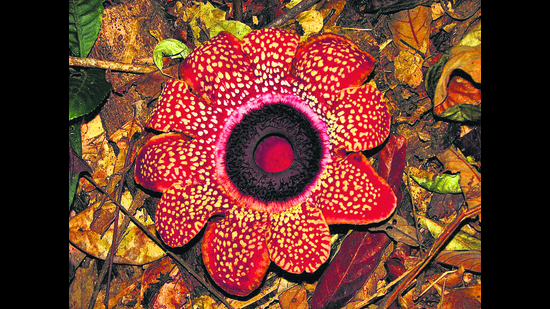Fleshy, flame-born, voracious: The world’s strangest flowers
There are some straight out of a horror movie: Parasites that burst from a vine. Others seem woven out of fantasy: translucent white ghosts, blooms born of fire
The world’s oldest known flower looked nothing like a bloom. It was vine-like, with no petals, and resembled a weed or herb.

The Montsechia vidalii thrived deep in Europe’s lakes, in the Cretaceous period, about 130 million years ago. Fossils discovered in Spain in 2015 confirmed that it had no nectar-producing features. What it did bear was fruit. Each bud contained a tiny seed.
There remain a host of strange flowers, among the 400,000 known species in the world.
Some are straight out of a horror movie: parasites that burst forth from a vine. Others seem woven out of fantasy: translucent white ghosts, or blooms born of fire. Take a look.
A key to the future: The tiny, purple Dicliptera polymorpha

This plant, which flourishes amid fire, was only discovered five years ago.
The Dicliptera polymorpha was first described in a study published in 2024, based on sightings in the Talegaon-Dabhade grasslands of Maharashtra, in 2020.
The plant bears similarities with species of Dicliptera found in Africa, which also bloom in response to flames. “The discovery is thus a reminder that Africa and the Indian subcontinent were once joined,” says Mandar Datar of the Agharkar Research Institute in Pune, who was part of the 2020 discovery team.
One of the plant’s two annual blooming cycles, Datar adds, is triggered by the wildfires that erupt amid hot, dry brush in April. These fires char the straggling, wiry stems from the previous season’s growth, clearing the way for a fresh crop.
“The temperature of rock on the plateau reaches 60 degrees Celsius in summer. And yet some species, like this one, flourish here,” he says. “If we are to look for climate-resilient traits in plants, this is the pool of species we should be studying.”
Confuse and consume: Darlingtonia californica
Also called the California pitcher plant, the carnivorous Darlingtonia californica exudes a sugary aroma that attracts spiders, bugs, worms, ants and bees.
When these insects settle on its bulbous head, expecting pollen, they find that it is covered in tiny, translucent openings. The confused insect need only make one small slip and it is now inside the plant, sliding down a viscous, narrow inner wall lined with hairs that nudge it further downwards, into a pool of digestive fluids.
Once native to the forested slopes of Northern California and Oregon, the California pitcher flourishes near bogs and creeks. How’s that for the stuff of nightmares?
The ghost that blooms: Monotropa uniflora

This parasitic plant grows 2 to 12 inches above the ground and bears translucent white flowers that inspire its common name: ghost pipe.
Native to the forests of Asia, North America and northern South America, the ghost plant grows in clusters, near a fungal host, because it lacks chlorophyll and must feed off the fungal web of mycorrhizae.
Among the indigenous Cherokee, the blossoms — with their bowed heads — are said to represent humility and friendship. In Cherokee lore, they are said to grow wherever friends have quarrelled.
Bursting forth: The Rafflesia
Like something out of a horror movie, the Rafflesia spreads its tendrils quietly through its host — typically a tropical vine — bursting forth, eventually, in the form of giant cabbage-like buds and then large malodorous flowers up to 3 ft in diameter.
These plants have been used for centuries in traditional medicine — to stem internal bleeding, treat fevers and as aphrodisiacs — by tribes in its native regions of South-East Asia (these include Sumatra, Indonesia, Brunei, the Philippines, Malaysia and Thailand).
Growing human activity within rainforests poses a threat to all 42 species of the Rafflesia.
A multinational research project led by the University of Oxford Botanic Garden concluded, in a paper published in 2023, that more than two-thirds (67%) of these species grow in regions that are unprotected by conservation laws.
India’s corpse flower: The rare Sapria himalayana Griffith

Also called the Hermit’s Spittoon, this parasitic plant is so rare, a sighting last year in Arunachal Pradesh was the first recorded one in 85 years.
Known for its putrid smell and red flowers with sulphur-yellow flecks, the Sapria himalayana was first described in 1836, by the British botanist William Griffith.
It grows in north-eastern India, parts of Bhutan, Tibet, south-central China, Myanmar, Thailand and Vietnam, and is closely related to the Rafflesia. It too inhabits vines and bursts forth as buds, which expand into blooms.
Relatively little is known about the Sapria himalayana. “Extensive research… has been challenging because of its infrequent, unpredictable, and secretive flowering patterns,” noted a research paper published in the Journal of Threatened Taxa in December, following the recent sighting.








